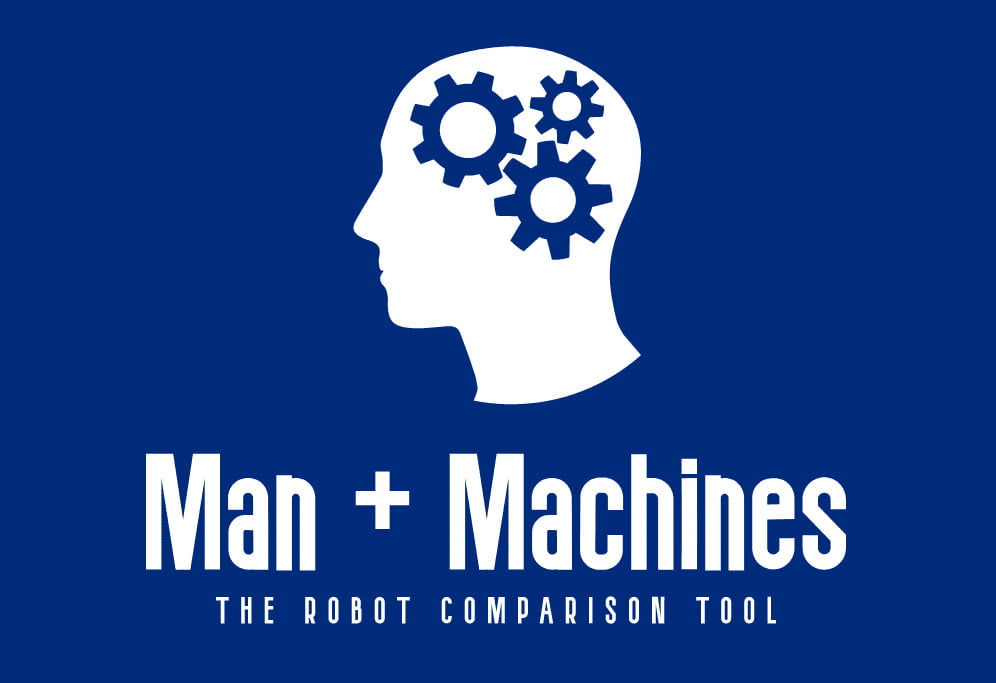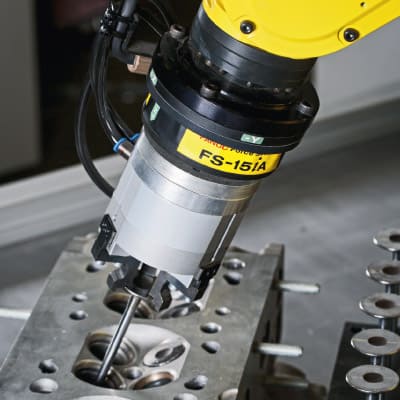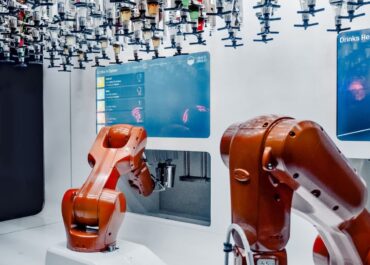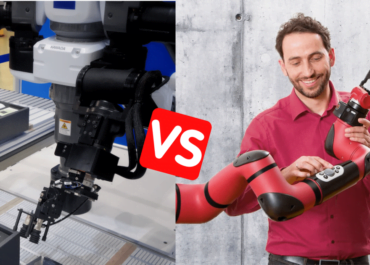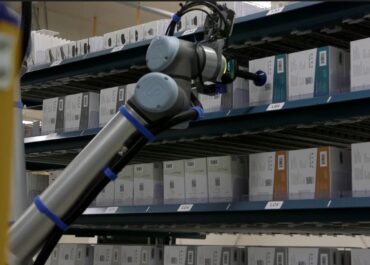An end effector is a tool attached to the end of a robotic arm to enable specific applications.
Although distributors’ robotic kits sometimes include end effectors, it is essential to choose the right one for your task. This ranges from a simple gripper to sanding and video camera kits.
But there are many options and manufacturers, and you might not always know which one fits best with the specific application you have in mind.
So here’s a guide to the different types of end effectors, the applications they support, and how to properly select them.
Gripping tools
These basic robotic end effectors are used to pick up, move and release parts of any size. They can operate either pneumatically (air driving the gripper), hydraulically (oil pump impulse), electrically (electrical feedback), or with vacuum cups.
Although pneumatic grippers are more compact and pneumatic grippers are more powerful, the most advanced models usually use electric servo and vacuum cups for their low cost and flexibility:
Hand Gripper

These grippers apply a mechanical force to objects, generally via electrical feedback. They come in all shapes and sizes:
- Two-finger grippers for manipulating regularly shaped parts
- Three-finger grippers for holding round, spherical or irregularly shaped objects
- Delicate-fingered grippers for gripping fragile or food items.
- Gripping tools with force sensors to improve gripping accuracy and reduce the risk of error
- Magnetic grippers to transport metal parts more easily
The most common applications are Pick&Place, parts assembly, machine loading, and sorting and packaging.
The best-known manufacturers of these grippers are OnRobot, Robotiq, WeissRobotics, Festo, Piab
Vacuum gripper

These gripping tools use the air pressure differences between the inside and the outside to suck and grip objects. They are equipped with suction cups to trap the air, which is often generated via electrical power. By enlarging or reducing the suction cup area, they can handle light objects of different types:
- Plastic parts, glass and metal sheets
- Cardboard packaging
- Wooden pallets
Due to their flexibility and sensitivity, they are particularly popular in the food, logistics and pharmaceutical industries. They are used in applications such as packaging and palletizing.
The main manufacturers of these equipments are OnRobot, Robotiq, Piab, Schmalz, Destaco, Coval.
Robot Screwer

With increasing agility, robots can now screw parts with great productivity. And collaborative robots especially stand out for their ability to adapt and refine their screwing movements continuously. So screwing kits are gaining a lot of momentum. They generally include :
- The screwdriver with an axis of movement from the inside to the outside. Works with electric feedback or with a vacuum pump.
- The screw distributor
- A torque sensor that calculates the right position, force and speed to apply to the screw
With these elements, production line managers can manage their screwing application on a wide variety of parts, from electrical assemblies to car bodies and equipment. All this with constant productivity and reliable results to the millimeter.
The various manufacturers of robotic screwdriving solutions are OnRobot, Stoeger, Robotiq, Montztorque, Visumatic and Weber.
Cutting tool

Although collaborative robots still don’t support them, cutting end effectors are regularly used by industrial robot owners.
Whether they are cutting, drilling, milling or machining tools, they benefit from the high repeatability and range of motion of articulated robots. Moreover, compared to CNC machines, they allow these cutting applications to operate 24 hours a day without human intervention. There are several types:
- Laser cutting tool
- Drilling and tapping module
- Milling effector
- Mechanical or ultrasonic cutting blade
Well-known manufacturers are Haalsti, Zagar, Setitec, as well as robot manufacturers (Fanuc, ABB, Motoman), and they are aimed at the automotive, aerospace and electronic sectors in particular.
Robotic dispensing systems

Painting, coating, spraying and gluing applications involve the handling of often toxic materials. So it’s no surprise that robots have become an enviable solution to automate these applications.
Manufacturers first relied on robots specifically designed for this task. But, more recently, they have valued the flexibility of more compact models like cobots to adapt and maximize material distribution on surfaces. They can also more easily reach remote or narrow surfaces.
These tools can take many forms:
- Air paint gun
- An atomizing paint bell. A new, more precise technology that spins at high speed to maximize material distribution.
- Paint brush
- Glue dispensing module
- Dispensing syringe
Leading manufacturers of these solutions are Fanuc, Arsenal, TurboSpray, ABCO, Robot27, AimRobotics.
Sanding and finishing tool

Although these are rather rewarding tasks, sanding, grinding and polishing can be dangerous and sometimes painful for workers. It is therefore natural to want to automate them.
On this subject, in addition to industrial robots, collaborative robots have distinguished themselves thanks to the delicacy and sensitivity of their gestures. Their advanced force sensor intelligently adapts the pressure it exerts on the material to achieve a desired result, while allowing human intervention in complete safety. These finishing tools are available on the market in kit form, generally comprising
- An orbital tool
- The abrasive support in contact with the material. Glued, applied or in brushes, they do not have the same finishing power.
- The electric motor or air impulse
- The optimization software
Well-known companies in the field are Robotiq, PushCorp, OnRobot, ATI, Fanuc. They generally support a large number of surfaces: metal, aluminum, wood, glass, plastic.
Welding torch

Welding is an application that has long been mastered by robots. As it is very dangerous and requires great precision, specific industrial robots are already widely used to perform this task.
With collaborative robots emerging, engineers designed end effectors that allow them to weld with great dexterity. These are most often arcs that use an electric current to melt the metal. They can also use air, liquid, or gas cooling technology to shape the flame.
Manufacturers specializing in these tools include Fanuc, Vectis, ABICOR BINZEL, EDR,
Force/Torque Sensor

With force and torque sensors, robots can feel the shapes of parts like humans. They can detect subtle differences in force and rotation that they can apply to a surface.
As a result, they can smoothly adapt to surface irregularities and apply the right pressure. While they are fairly new technologies for traditional robots, they have become commonplace for collaborative robots. Now, many manufacturers provide those sensor end effectors to handle precise applications:
- Accurate insertion of assembly parts with milimeter feedback
- Precise polishing, grinding, and contouring of surfaces
- Inspection and quality control of parts
These manufacturers include Fanuc, Robotiq, OnRobot, Epson, Mitsubishi, Tekscan.
Computer vision module

Who has never dreamed of a robot that can see? For applications such as Pick & Place, computer vision end effectors are even essential for robots to detect and pick up parts from different positions and angles. This makes Pick & Place and quality control applications more flexible and enables different distribution flows at the same time.
These modules are often supplied in a kit that includes:
- A camera that automatically adjusts its brightness and focus
- A software to calibrate and program the vision
- An intelligent image learning model that adapts to photographic conditions
Many manufacturers provide this technology, but the main ones are Fanuc, Sick, VEX, Omron, OnRobot or Baumers.
Robotic Tool Changers

End effector manufacturers also got the idea of creating tool changers to switch from one application to another. By equipping robots with two end-effectors or more at the same time, they allow robots -often collaborative- to handle complex applications.
They enable multiple tool combinations :
- A gripper plus a gluing device
- A vision module plus a gripper
- A screwing kit plus a vision tool
- A gripper plus a force sensor
The main distributors are ATI, OnRobot, TripleA, Destaco, Staübli.
How do you choose the right end effector for your robot?
Now that you know which end effector fits your needs, how do you find the best brand or model for your application? This involves a step-by-step search:
- Consider the application you want to automate and the goals you want to achieve. Do you want an end effector to improve productivity, quality or accuracy of output, task safety?
- Learn about the different types of end effectors suitable for your application from the list in this article.
- Compare their performance against your goals (accuracy, speed, force), their price and their compatibility with your robot.
- Once you have purchased it, do a risk assessment of the new tool.
- Set up the end effector on the robotic arm and train your teams on this solution.
Now you can enjoy the benefits of your end effector on your production process! And if you want a more in-depth comparison of cobotic models, check out our guide.
